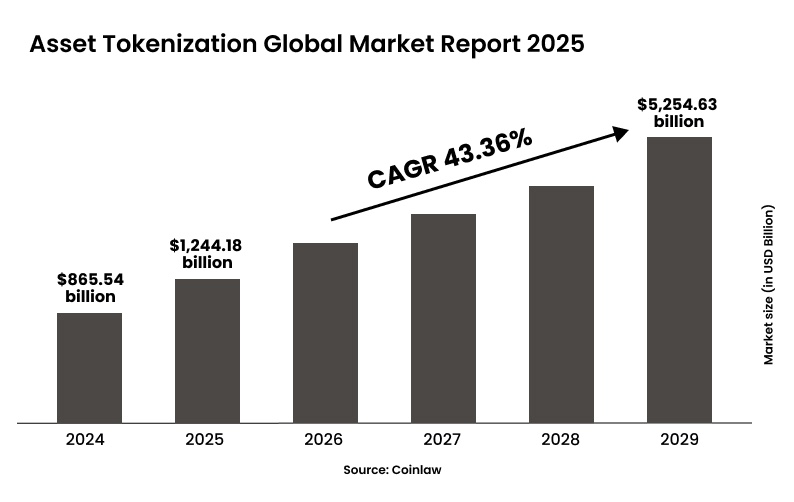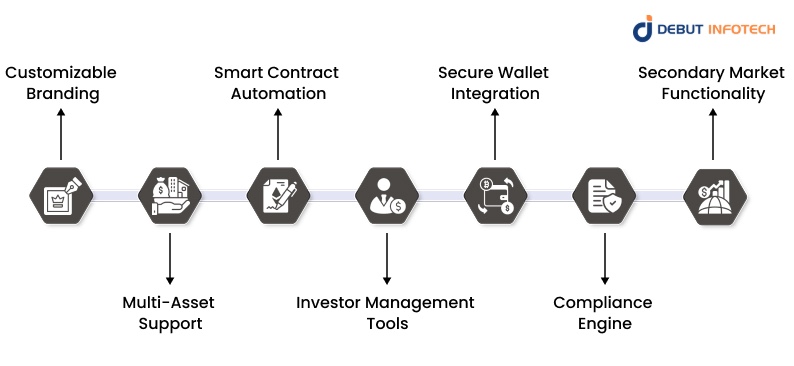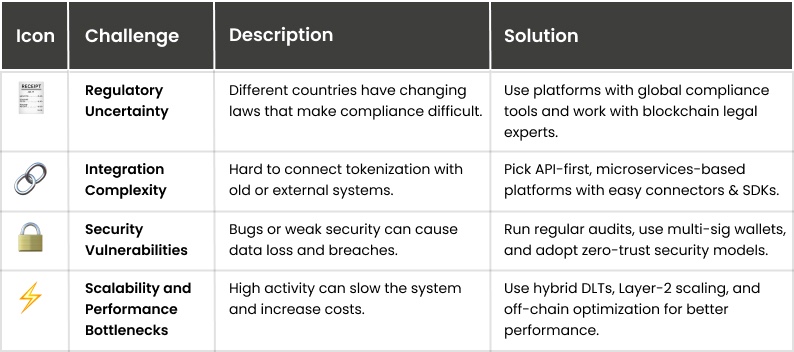Table of Contents
Home / Blog /
White Label Tokenization Platform: Features, Standards, and Strategic Success Factors
October 23, 2025

October 23, 2025
A white label tokenization Platform allows businesses to issue, manage, and trade digital assets under their own brand without creating complex blockchain infrastructure. As tokenization expands, its impact is becoming clear.

The real world asset (RWA) tokenization market has grown to $24 billion as of mid-2025, nearly five times its 2022 value, according to a CoinDesk report. Moreover, the global tokenized asset market is projected to reach $1.24 trillion by the end of the year, per CoinLaw. These numbers illustrate how tokenization is transforming ownership and liquidity across various industries.
In this guide, we will explore the key features, compliance standards, and practical strategies for achieving success with white label tokenization solutions.
Launch Your Tokenization Platform Fast
Get your white label tokenization platform up and running in weeks, not months. Our experts handle the tech, compliance, and deployment so you can focus on growth.
Understanding White Label Tokenization Platform
A white label tokenization platform provides ready-to-deploy infrastructure for businesses to issue and manage digital tokens without building systems from scratch. It simplifies the process of converting physical or digital assets into blockchain-based tokens while allowing companies to maintain full control of branding, compliance, and user experience. This model suits enterprises that want to launch tokenized products quickly while retaining institutional-grade functionality.
Benefits of White Label Tokenization Platform
1. Faster Deployment
White label solutions drastically reduce the time to market. Instead of developing a tokenization system internally, businesses can implement pre-built modules and deploy their products within weeks. This rapid setup enables organizations to capitalize on market opportunities and respond more quickly to investor demand.
2. Lower Costs
Building a tokenization system from scratch requires extensive development, audits, and infrastructure costs. White label platforms reduce these expenses by providing a reliable and secure foundation that has already been tested. The savings enable businesses to allocate funds to marketing, asset acquisition, and investor relations.
3. Brand Customization
With white label tokenization, companies can maintain their brand identity while enjoying the benefits of convenience. Every interface—from dashboards to investor portals—can reflect the organization’s design language. This fosters trust and recognition among investors while reinforcing the company’s market positioning.
4. Scalability
As tokenized assets grow, scalability becomes essential. Most white label tokenization platforms are designed with a modular architecture and cloud-based infrastructure, enabling seamless expansion as trading volume and investor activity increase.
Related Read: How to Launch a White Label Tokenization Platform
Core Features of a White Label Tokenization Platform

1. Customizable Branding
The platform should allow full control over design, color schemes, and branding elements. A white label asset tokenization solution ensures the end product appears proprietary, helping institutions deliver a consistent investor experience.
2. Multi-Asset Support
A robust tokenization platform supports various asset classes, including real estate, equities, funds, and art, all under one ecosystem. This flexibility enables businesses to diversify their offerings and manage multiple investment vehicles through a unified interface.
3. Smart Contract Automation
Smart contracts automate issuance, distribution, and compliance events. They eliminate manual processes, reduce operational risks, and ensure transparent execution aligned with predefined conditions.
4. Investor Management Tools
Investor dashboards, onboarding systems, and reporting tools are integral to maintaining engagement and trust. Advanced analytics enable issuers to track investor participation, dividends, and compliance records with ease.
5. Secure Wallet Integration
Built-in wallets with multi-signature and HSM-based security ensure assets remain protected. Integration with trusted custodians further strengthens the security layer for both institutional users and individual investors.
6. Compliance Engine
The compliance engine automatically enforces jurisdiction-specific rules. The engine for regulatory compliance in tokenization supports KYC/AML verification, whitelist management, and continuous monitoring to prevent breaches and ensure lawful operations.
7. Secondary Market Functionality
The platform should allow trading on internal or integrated secondary markets. This liquidity layer enhances investor confidence by enabling easy entry and exit from tokenized assets.
Key Features to Look for in a White Label Tokenization Platform
1. Enterprise-Grade Architecture
a) Microservices-first
This approach divides the platform into independent, deployable services. Each module can scale or update individually, improving fault tolerance, uptime, and system agility for enterprise tokenization infrastructure.
b) API-first architecture
An API-first model ensures every function is accessible programmatically. It simplifies third-party integrations with exchanges, custodians, and compliance tools while guaranteeing smooth, standardized data interactions.
c) Secure gateway management
Secure gateways authenticate users, filter API requests, and encrypt traffic between internal services and external systems. This prevents unauthorized access, mitigates cyber threats, and ensures data integrity across tokenized ecosystems.
2. Permissioned DLT with Public/Private Hybrid Support
a) Upgradeable Smart Contracts
Upgradeable smart contracts allow code changes without redeployment. This feature ensures flexibility in updating compliance logic, governance structures, and asset terms as regulations or business needs evolve.
b) Oracle and L2 Support
Oracle and L2 support enhance scalability, accuracy, and interoperability. It connects real-world data sources while using Layer 2 solutions to reduce transaction costs and latency in token operations.
I. Hybrid oracle mesh
The hybrid oracle mesh aggregates data from multiple off-chain and on-chain sources. It enhances accuracy, mitigates single-point failure, and provides verifiable, tamper-resistant data for smart contract execution.
II. IoT and AI integration
IoT devices feed real-time data to AI models, automating asset tracking and performance analysis. This combination enables dynamic token updates for physical or data-driven digital assets.
III. Support for L2s and EVM bridges
Layer 2 networks and EVM bridges enhance scalability and interoperability between chains. They reduce gas costs, enable faster settlements, and expand access across public and private ecosystems.
3. Institutional-Grade Compliance, Security & Governance
a) Multi-jurisdictional logic
This feature automatically applies compliance rules across regions. It ensures a smooth token Issuance process, transfers, and reporting meet specific jurisdictional standards without manual intervention or legal inconsistencies.
b) Auto-generated compliance docs
The platform generates audit-ready documentation in real time. Each transaction, investor verification, and compliance event is recorded and organized to streamline reporting and meet regulator expectations.
c) KYC/AML Integration & Privacy
Built-in KYC/AML tools verify investor identities using third-party plug-ins. Zero-knowledge protocols ensure that private data is validated without exposure, thereby preserving investor confidentiality and maintaining regulatory trust.
I. Third-party plug-ins
The platform integrates with external KYC providers, enabling seamless identity verification. This ensures faster onboarding and consistent compliance, eliminating the need for duplicate verification across different jurisdictions.
II. Zero-knowledge compliance
Zero-knowledge proofs validate compliance without revealing user data. This privacy-first approach strengthens investor trust and meets global data protection requirements while maintaining audit readiness.
d) Token Custody & Governance
Custody mechanisms use multisig and HSM-based wallets to safeguard assets. Combined with governance controls, they maintain transparency in decision-making and protect digital holdings from unauthorized use.
I. Multisig + HSM-based wallets
Multi-signature authorizations add layered security standards for blockchain platforms, while hardware security modules (HSMs) protect cryptographic keys. Together, they ensure institutional-grade protection for token storage and transfer operations.
II. On-chain and off-chain syncing
Synchronized on-chain and off-chain records prevent data discrepancies. This guarantees consistent visibility between blockchain transactions and internal databases, improving auditability and operational accuracy.
e) Continuous Smart Contract Security
Continuous security monitoring through CI/CD pipelines enables early detection of vulnerabilities. Regular code reviews, formal audits, and bounty programs sustain platform reliability and protect investor confidence.
I. CI/CD pipelines with DevSecOps
CI/CD pipelines embed security into every deployment stage. DevSecOps automates testing and monitoring, ensuring only verified, vulnerability-free smart contracts reach the production environment.
II. Formal audits & bounties
Independent audits and structured bounty programs help identify security flaws before they can be exploited. They promote transparency, strengthen reliability, and attract investor confidence in tokenized assets.
4. High-Liquidity Markets & Integrated Trading Infrastructure
a) Matching engine or integrations
Matching engines facilitate instant trade execution, connecting buyers and sellers efficiently. External exchange integrations further expand liquidity pools, fostering an active and transparent token trading ecosystem.
b) AMM module
Automated Market Maker (AMM) modules maintain liquidity through algorithmic pricing models. They enable decentralized, continuous trading while minimizing slippage and enhancing user accessibility.
c) Collateral & Leverage Infrastructure
Collateralized systems allow token-backed lending and margin trading. Smart margin rules maintain balance, protect against liquidation, and ensure responsible leverage usage for investors.
I. Tokenized collateral
Tokenized collateral represents real-world or digital assets backing financial instruments. It ensures transparency, liquidity, and verifiable ownership while enabling automated liquidation if collateral value drops.
II. Smart margin rules
Smart contracts enforce pre-set margin thresholds. They automatically rebalance positions or liquidate assets when limits are breached, minimizing loss exposure for both traders and platforms.
d) Portfolio Tools & Yield Mechanics
Advanced portfolio tools display holdings, performance analytics, and yield metrics in real time. Yield mechanics, such as rebasing vaults, optimize returns and enhance user engagement.
I. Yield tokens & rebasing vaults
Yield tokens distribute rewards periodically, while rebasing vaults adjust token supply to reflect returns automatically. Together, they sustain liquidity and offer transparent yield distribution.
II. Investor dashboards
Investor dashboards centralize portfolio insights, transaction records, and yield data. They offer intuitive reporting, allowing investors to track performance and manage holdings effectively.
Also Read: Real Estate Tokenization Platform Cost
Common Use Cases of White Label Tokenization Platform
1. Real Estate
Real estate tokenization divides properties into fractional digital tokens, allowing investors to own and trade shares of high-value assets. This structure enhances liquidity, lowers entry barriers, and enables global investors to access real estate opportunities without geographical or financial limitations.
2. Art
Art tokenization transforms valuable artworks into tradable digital assets. Collectors can purchase fractions of paintings or sculptures while artists gain new monetization channels. This model preserves authenticity, records provenance on-chain, and makes fine art investment accessible to a broader audience.
3. Commodities
Tokenizing commodities like gold, silver, or oil streamlines ownership tracking and settlement. Each token represents a verifiable claim on a physical reserve, enhancing transparency, mitigating counterparty risk, and facilitating faster trade execution in both traditional and decentralized markets.
4. Intellectual Property (IP)
Tokenized IP allows creators to monetize royalties and licensing rights more efficiently. By representing patents or copyrights as tokens, ownership transfers and revenue distributions become automated through smart contracts, ensuring creators receive fair compensation and investors access predictable income streams.
5. Equity Tokens
Equity tokens represent digital shares in private or public companies, offering investors regulated exposure to equity markets on blockchain networks. This approach simplifies fundraising for startups, enhances liquidity for shareholders, and introduces transparency through immutable transaction records and investor tracking.
6. Infrastructure & Green Energy
Tokenization enables investors to fund renewable energy projects and infrastructure developments. Each token reflects a stake in energy outputs or assets, providing traceable investment flows, transparent reporting, and sustainable financing opportunities aligned with ESG-focused initiatives and global green finance goals.
Strategies for Success with White Label Tokenization
1. Conducting Market and Regulatory Research Before Launch
Thorough market and regulatory research identifies suitable jurisdictions, compliance obligations, and investor expectations. This minimizes legal risks, supports license acquisition, and ensures that tokenized offerings align with global standards and investor protection frameworks.
2. Building Strong Liquidity Networks and Partnerships
Liquidity defines token success. Partnering with exchanges, custodians, and institutional investors helps build market depth and increase transaction flow. Collaborative ecosystems foster credibility and help issuers maintain consistent trading volumes post-launch.
3. Prioritizing User Experience and Investor Trust
User interfaces must be intuitive, secure, and transparent. Simplified onboarding, responsive dashboards, and visible audit trails build investor trust, reduce friction, and ensure consistent engagement throughout the investment token lifecycle.
4. Leveraging Automation and AI for Compliance and Reporting
Automation powered by AI streamlines KYC, AML, and ongoing compliance reporting. These systems detect anomalies in real time, reducing manual oversight and ensuring operational accuracy while adhering to evolving regulatory requirements.
5. Continuous Upgrades to Align with New Token Standards and Rules
Blockchain regulations and token standards evolve rapidly. Regular tokenization software updates, smart contract improvements, and the integration of emerging protocols ensure long-term relevance, compliance, and a competitive advantage for issuers and investors alike.
Common Challenges and How to Overcome Them

1. Regulatory Uncertainty
Tokenization companies operate across multiple jurisdictions, each with distinct and evolving regulations. This creates compliance complexities that can stall project timelines and raise operational risks, especially for institutions seeking cross-border functionality and alignment with securities, AML, and data protection laws.
Solution
Adopt platforms with integrated, multi-jurisdictional compliance logic and automated reporting tools. Use legal partners familiar with blockchain and tokenization regulations to ensure documentation aligns with current requirements. Implement dynamic compliance modules that update in response to changing laws, ensuring tokenized operations remain continuously compliant across different regions.
2. Integration Complexity
Integrating tokenization platforms with legacy systems, ERP software, and external market infrastructure can be a complex process. Data silos, differing protocols, and incompatible APIs often slow deployment, leading to fragmented workflows and operational inefficiencies that reduce scalability and market readiness.
Solution:
Choose platforms built with API-first, microservices architecture for seamless integration. Prioritize systems that offer plug-and-play connectors and SDKs compatible with existing enterprise tools. Establish DevOps-led platform scalability and integration pipelines and automate testing to ensure efficient system interoperability and smooth token lifecycle management.
3. Security Vulnerabilities
Tokenized assets are exposed to various cybersecurity risks, including smart contract bugs, wallet breaches, and data leaks. Weak DevSecOps practices or unverified smart contracts can lead to severe losses, reputational damage, and compliance violations that undermine investor confidence and institutional adoption.
Solution:
Implement continuous security audits, bug bounties, and formal verification for all smart contracts to ensure robust security. Enforce HSM-based custody systems, multi-signature wallets, and CI/CD pipelines with embedded security checks. Use zero-trust models to minimize attack vectors and maintain a secure tokenization environment.
4. Scalability and Performance Bottlenecks
As transaction volumes grow, tokenization systems may experience latency and gas cost spikes, especially on congested blockchains. This impacts user experience, slows settlements, and restricts the platform’s ability to support institutional-scale operations or high-frequency trading environments.
Solution:
Partner with a reliable asset tokenization development company that adopts hybrid DLT frameworks supporting L2 rollups and EVM-compatible scaling. Implement off-chain computation and caching for high-volume tasks to optimize performance. Utilize modular architectures to allocate resources dynamically, ensuring transaction efficiency, speed, and throughput while maintaining decentralization and security.
Partner With Experts in Tokenization
Collaborate with a team that has been building blockchain platforms for years. We bring experience, reliability, and long-term technical support.
Conclusion
A white label tokenization platform provides a structured route to securely digitize and trade assets. Its value lies in flexibility, automation, and compliance readiness.
With the right setup—encompassing modular design, integrated wallets, smart contracts, and multi-jurisdictional compliance—businesses can scale their token operations with confidence. Strategic partnerships, continuous updates, and AI-driven reporting all contribute to long-term sustainability.
Organizations that invest in these capabilities not only future-proof their operations but also unlock greater liquidity, efficiency, and investor confidence in a rapidly expanding digital asset ecosystem.
FAQs
Begin by selecting a reputable provider that offers customization, security, and regulatory compliance. Define your token model, integrate KYC/AML tools, and set up smart contracts. Once your platform is configured and tested, you can launch it and start onboarding investors or asset owners.
It usually takes between four and eight weeks, depending on customization and regulatory requirements. Basic setups can go live faster, while projects needing complex features, smart contract audits, or multi-asset integration might take longer. The provider’s experience and support also influence how quickly you can launch your project.
A white label tokenization platform converts real-world assets into digital tokens on the blockchain. It handles everything from token creation and compliance checks to investor management and secondary trading. You get a ready-made system under your own brand, without needing to build the tech from scratch.
Costs depend on features, customization, security requirements, and regulatory compliance needs. You’ll typically pay for setup, maintenance, licensing, and blockchain transaction fees. Some providers charge a one-time fee, while others use subscription models. Budgeting for smart contract audits and compliance tools is also a smart move.
Look for a provider with proven experience, strong compliance features, and end-to-end security. Evaluate the platform’s customization options and determine if it supports your preferred blockchain. Good customer support, transparent pricing, and regular software updates are also key factors to consider before making a final decision.
Talk With Our Expert
USA
2102 Linden LN, Palatine, IL 60067
+1-708-515-4004
info@debutinfotech.com
UK
Debut Infotech Pvt Ltd
7 Pound Close, Yarnton, Oxfordshire, OX51QG
+44-770-304-0079
info@debutinfotech.com
Canada
Debut Infotech Pvt Ltd
326 Parkvale Drive, Kitchener, ON N2R1Y7
+1-708-515-4004
info@debutinfotech.com
INDIA
Debut Infotech Pvt Ltd
Sector 101-A, Plot No: I-42, IT City Rd, JLPL Industrial Area, Mohali, PB 140306
9888402396
info@debutinfotech.com




Leave a Comment